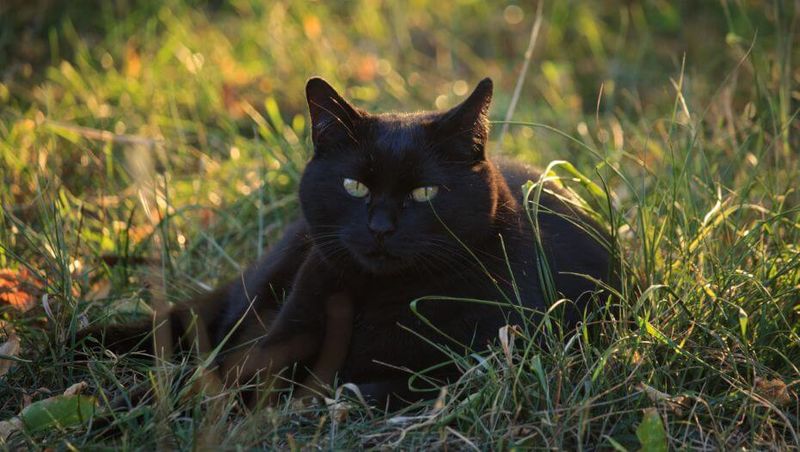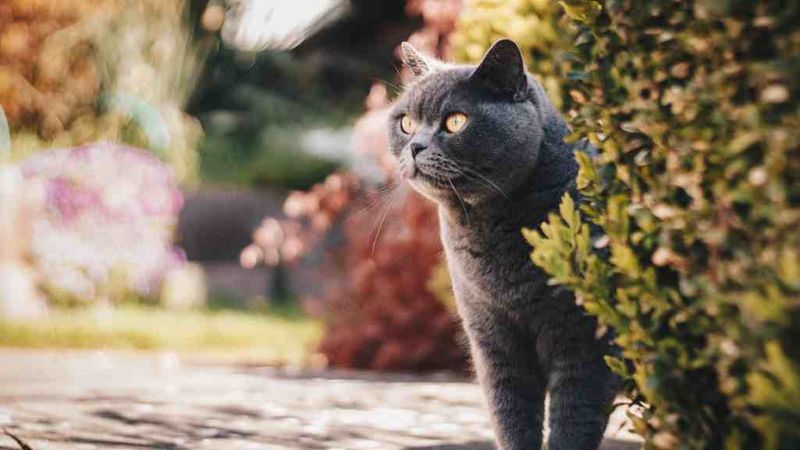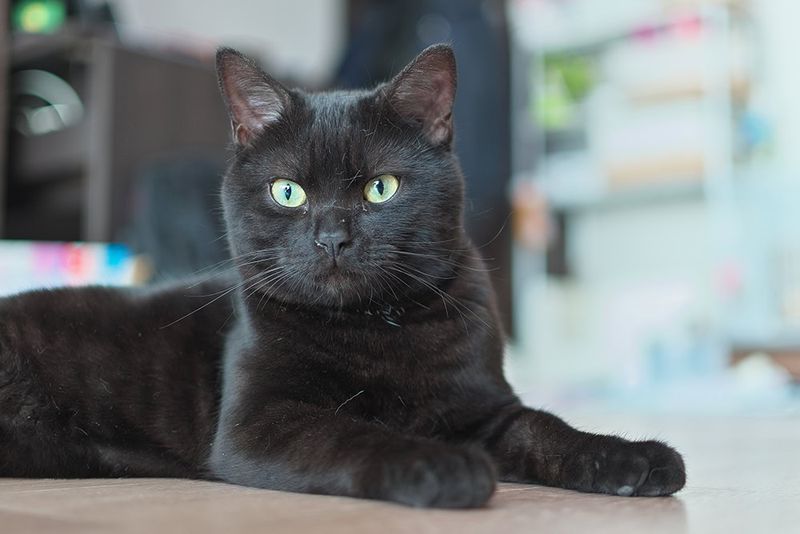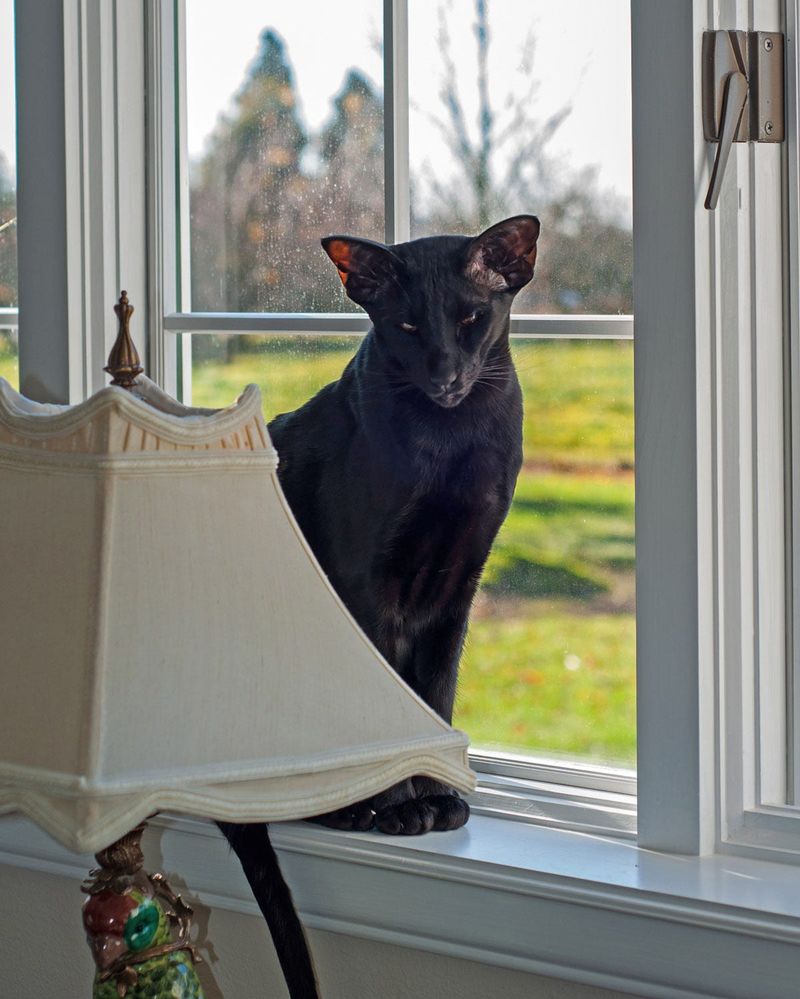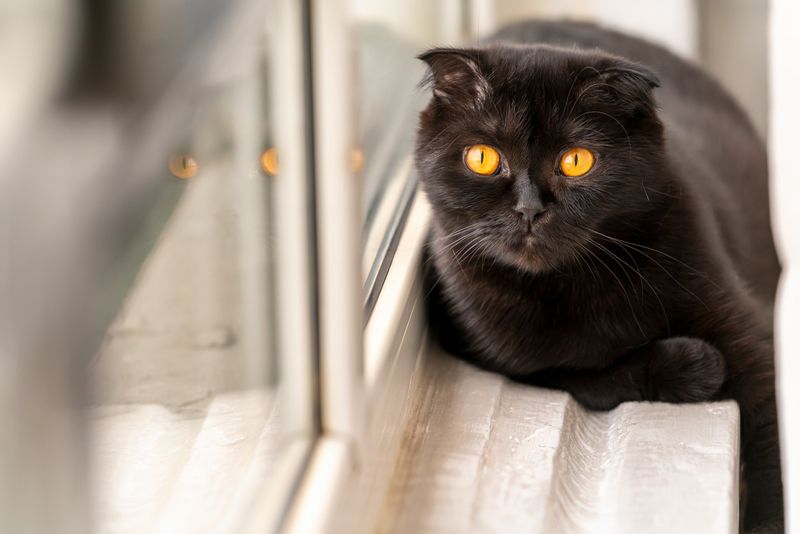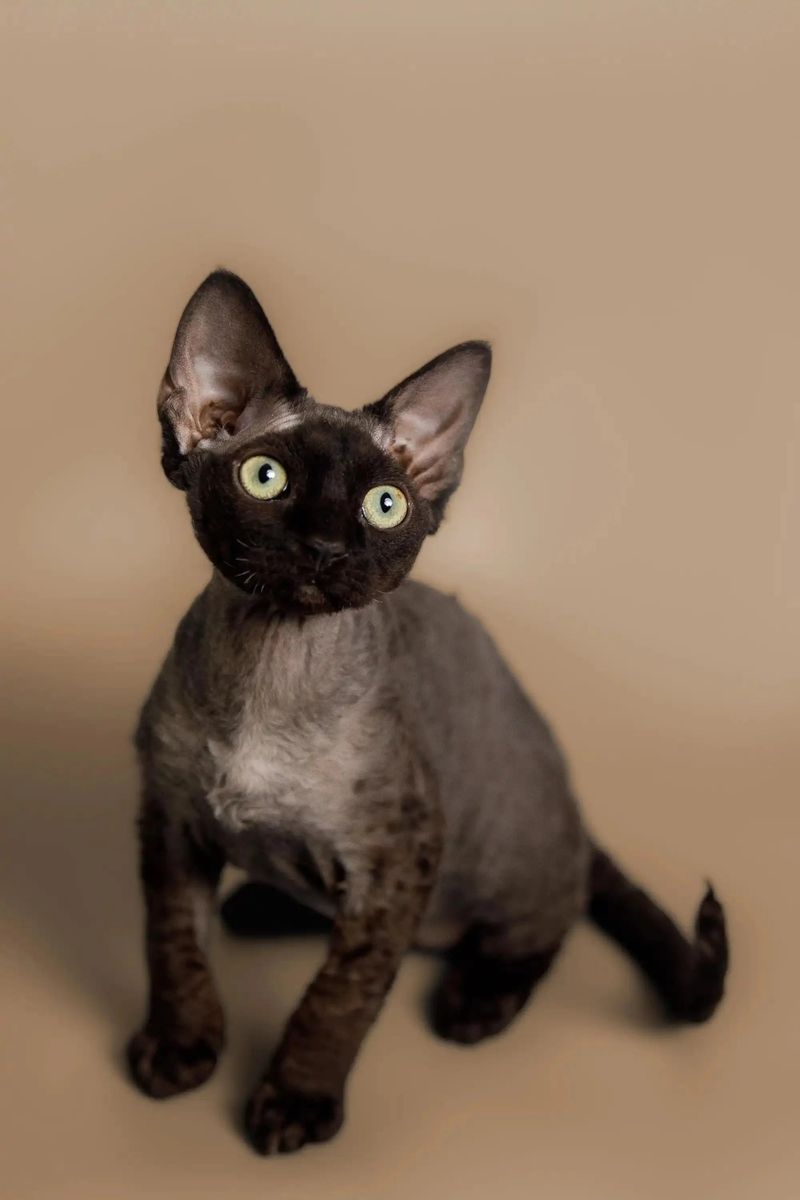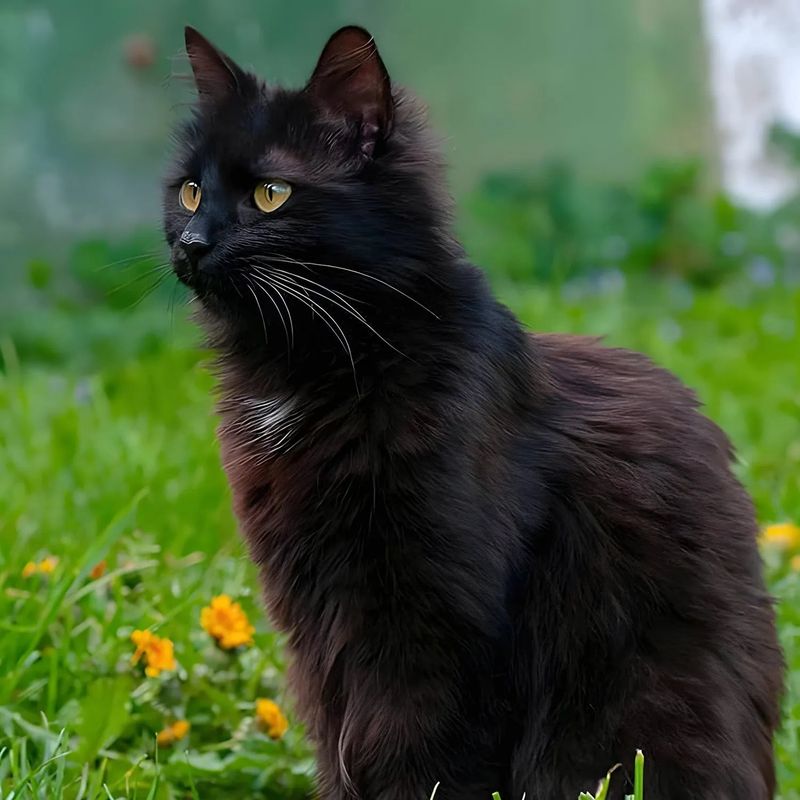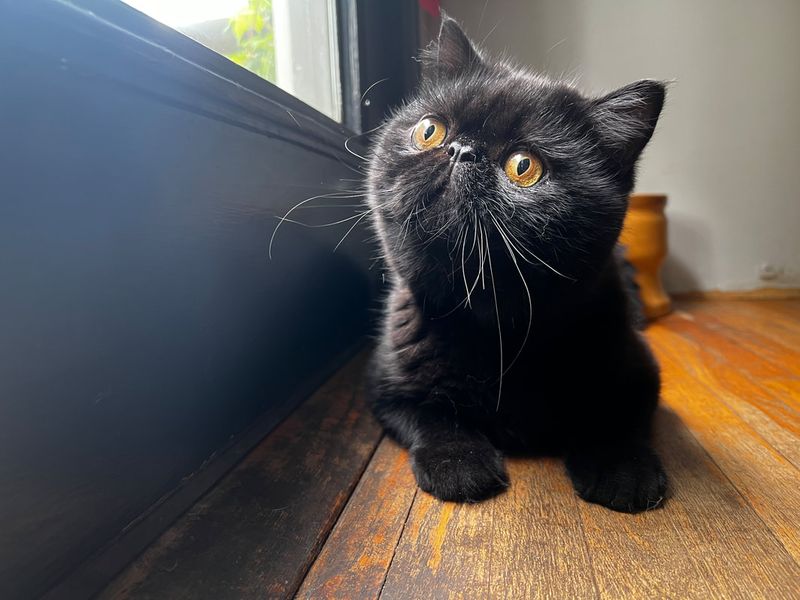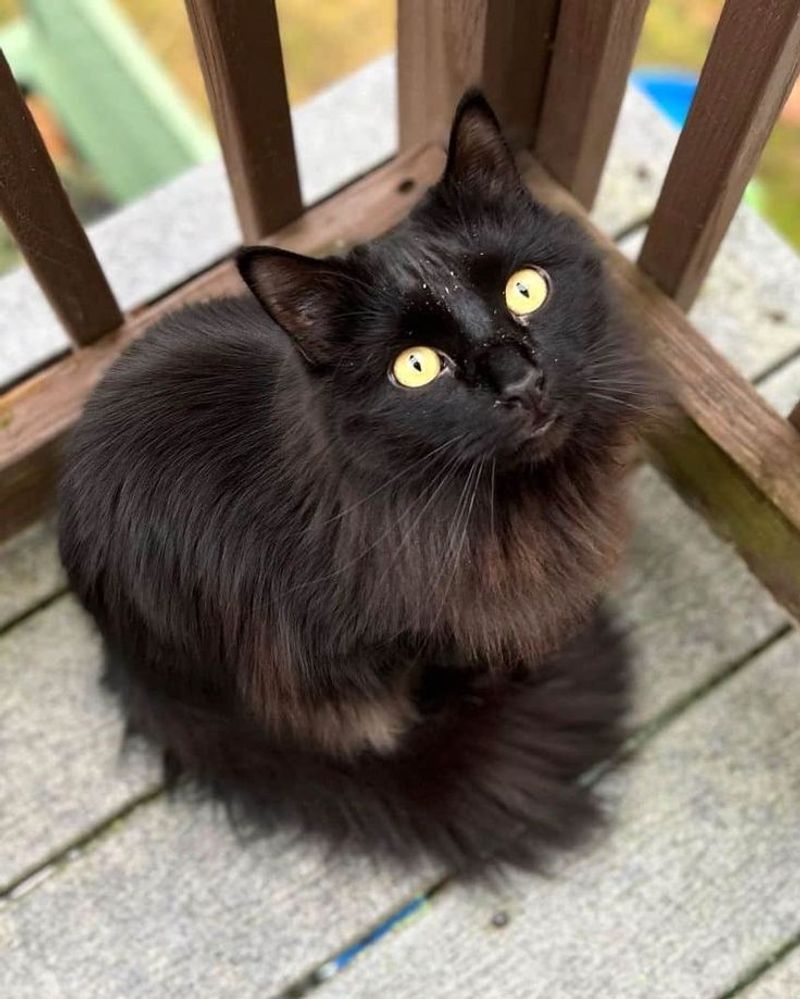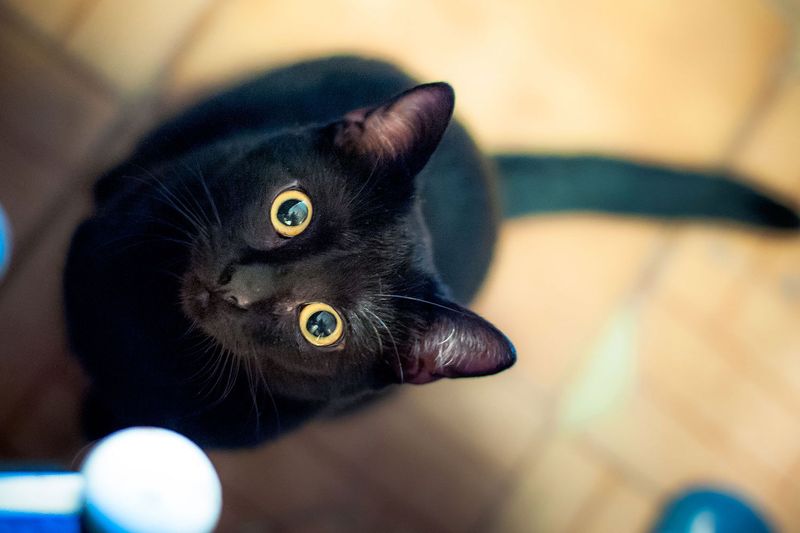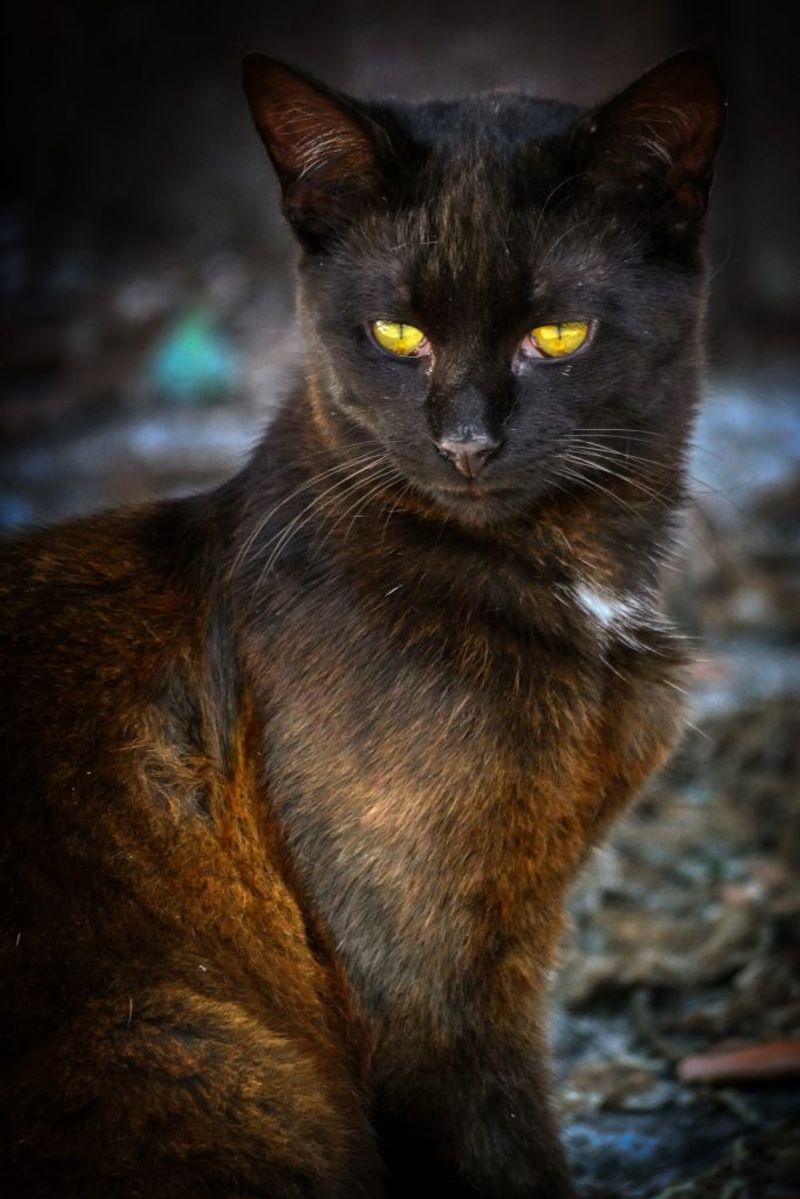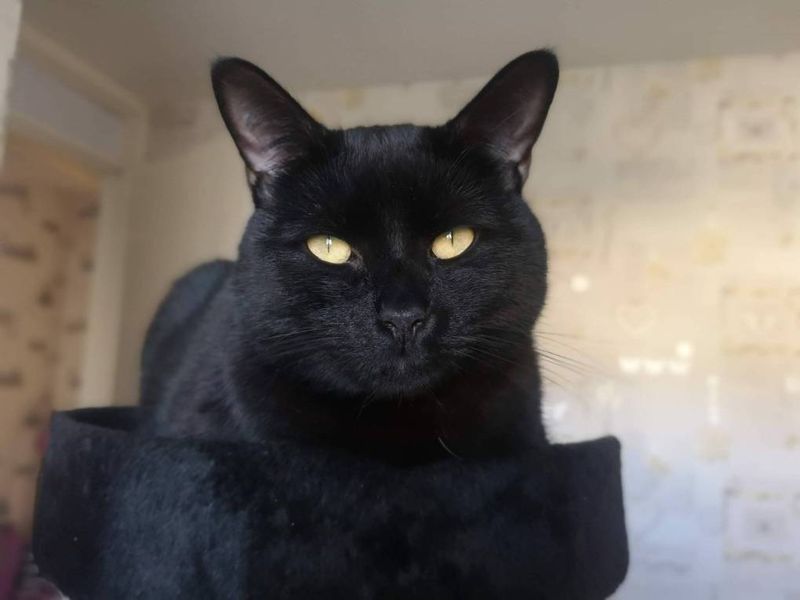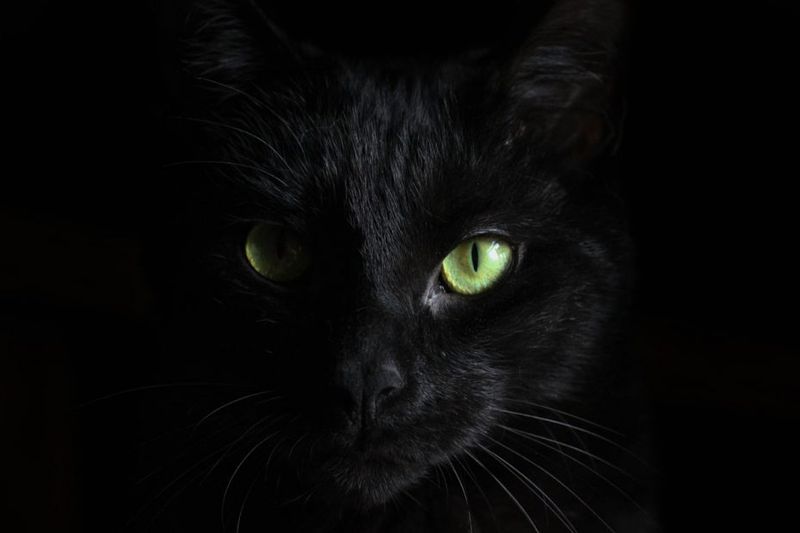📖 Table of Content:
Black cats make wonderful apartment companions with their sleek looks and adaptable personalities. These ebony furballs come in various breeds, each with unique traits perfect for smaller living spaces. While they’re actually great pets, black cats have faced centuries of strange superstitions that still affect adoption rates today.
1. Bombay
Sleek and muscular, Bombay cats resemble miniature panthers with their glossy black coats. Their striking copper eyes contrast beautifully against their midnight fur, creating a truly majestic appearance. Bombays are famously affectionate and love being part of family activities.
These sociable felines enjoy playtime but don’t require excessive exercise, making them ideal for smaller spaces. Known for their dog-like loyalty, many Bombays will follow their owners from room to room, always ready for cuddles. Their moderate energy levels and adaptable nature make them perfect apartment dwellers.
2. British Shorthair
With their round faces and dense black coats, British Shorthairs bring a touch of quiet elegance to any apartment. Sturdy and calm, they’re low-maintenance companions who thrive indoors—even if they prefer sitting beside you over on your lap.
They prefer being near you rather than on you, respecting personal space—a valuable trait in apartments. Naturally calm and independent, these cats don’t mind being alone during work hours. Their soft purrs and minimal vocalization keep the peace with neighbors, while their low-maintenance grooming needs suit busy city dwellers.
3. American Shorthair
These hardy, black-coated cats may have descended from shipboard mousers, but American Shorthairs are right at home in modern apartments. They’re playful, self-sufficient, and surprisingly affectionate when they choose.
They enjoy interactive play sessions but won’t demand constant attention, making them ideal for busy apartment dwellers with varying schedules. Their easygoing personality extends to children and other pets, creating harmony in multi-pet households. With moderate activity needs and healthy constitutions, these cats thrive in apartments while providing companionship without overwhelming neediness.
4. Oriental Shorthair
Dramatic in both looks and voice, black Oriental Shorthairs thrive in apartments. Their elegant, lean frames and expressive features command attention—usually with a meow to match.
Social butterflies by nature, these cats form deep bonds with their humans. They’ll chat with you through their distinctive meows and chirps, always keeping you company during home activities. Mental stimulation matters more than space for these intelligent felines. Puzzle toys, training sessions, and interactive playtime keep them fulfilled in smaller homes. Their attachment-focused personality means they prefer being where you are, making apartment size less important than quality time.
5. Scottish Fold
Adorably unique, black Scottish Folds capture hearts with their signature folded ears and round owl-like faces. Their sweet expressions match their gentle personalities, making them delightful apartment companions. Scottish Folds adapt easily to apartment routines and noise levels.
These even-tempered cats rarely get startled by delivery knocks or neighbor sounds, maintaining their composure in urban environments. Despite their laid-back nature, they enjoy interactive play sessions that keep them mentally engaged. Many Scottish Folds develop cute habits like sitting up on their haunches or sleeping on their backs—charming behaviors that brighten small living spaces with big personality.
6. Devon Rex
Mischievous and playful, black Devon Rex cats bring elfin charm to apartment living with their large ears, wavy coats, and impish expressions. These social butterflies thrive on human interaction and quickly become the apartment’s entertainment director. Devon Rex cats stay kitten-like well into adulthood, finding joy in simple pleasures like chasing toys or playing fetch.
Their moderate size and light build let them navigate apartment spaces without causing disruption. Heat-seekers by nature, these cats often burrow under blankets or cuddle close for warmth. Their low-shedding wavy coats benefit allergy-prone apartment dwellers while requiring minimal grooming—a practical bonus for busy urban lifestyles.
7. Siberian
Robust yet gentle, black Siberian cats bring forest cat majesty to apartment living. Despite their impressive size and luxurious triple coat, these Russian natives adapt surprisingly well to indoor environments when given proper enrichment. Siberians combine playfulness with a calm demeanor that suits apartment life.
They enjoy interactive games but won’t bounce off walls when bored, instead finding sunny spots for peaceful napping between play sessions. Naturally athletic, these cats appreciate vertical space more than floor square footage. A sturdy cat tree or wall shelves satisfy their climbing instincts while keeping your apartment footprint manageable. Their quiet chirping vocalizations won’t disturb neighbors, unlike some more talkative breeds.
8. Exotic Shorthair
Teddy-bear faces and plush coats make black Exotic Shorthairs irresistibly huggable apartment companions. These Persian relatives bring the same sweet temperament but with easier maintenance, perfect for busy city dwellers. Exotic Shorthairs master the art of relaxation, content to lounge peacefully while you work from home.
Their quiet nature and minimal vocalization keep apartment living harmonious, even in buildings with thin walls. Low-energy by design, these cats don’t require extensive exercise space to stay happy. Simple toys and occasional play sessions satisfy their modest activity needs, while their affectionate nature ensures plenty of quality bonding time. Their adaptable personality suits changing apartment routines and various household compositions.
9. Ragdoll
Gentle giants with puppy-like devotion, black Ragdolls bring surprising compatibility to apartment living despite their size. These blue-eyed beauties earned their name from their tendency to go limp with relaxation when held—a charming trait for cuddle-loving apartment dwellers. Ragdolls typically greet you at the door and follow you from room to room.
Their quiet voices and patient demeanor make them ideal for shared walls and close quarters. Unlike some active breeds, Ragdolls don’t need extensive running space to stay content. Their moderate energy levels focus more on interactive play and companionship rather than high-energy antics that require large areas, making them surprisingly suitable for apartment lifestyles.
10. They bring bad luck
Crossing paths with a black cat brings bad luck? Pure nonsense rooted in medieval superstition! This harmful myth originated during witch hunts when black cats were unfairly associated with witchcraft, leading to centuries of discrimination against these beautiful animals. Cultures worldwide actually view black cats quite differently.
In Japan, they’re considered lucky symbols that attract potential suitors. British sailors historically welcomed black cats aboard ships as good luck charms for safe voyages. Modern shelters report black cats have lower adoption rates solely because of lingering superstitions. The truth? These midnight-colored companions bring the same joy, companionship, and apartment-friendly benefits as cats of any other color—without any supernatural baggage.
11. They’re witches’ familiars
The notion that black cats serve as witches’ magical assistants dates back to the Middle Ages. During this dark period of history, elderly women living alone with cats were often accused of witchcraft, creating an unfair association that persists today.
This harmful stereotype reached its peak during the witch trials, when both women and their feline companions faced persecution. Halloween decorations and media portrayals continue reinforcing this connection, despite having no basis in reality. Modern black cats are simply loving companions with no supernatural connections. Their intelligence and sometimes mysterious demeanor might seem magical, but these qualities make them wonderful apartment pets rather than mystical beings. Their true magic lies in their ability to transform a living space into a home.
12. They can steal your soul
Among the strangest myths, the belief that black cats can somehow capture human souls through their gaze has no factual basis whatsoever. This superstition likely developed from their intense staring behavior—actually just normal feline curiosity and communication. Black cats’ striking yellow or green eyes appear especially prominent against their dark fur, creating a mesmerizing effect.
This natural contrast led to misinterpretations in less scientifically informed times, particularly in cultures where eyes were considered windows to the soul. The reality? Those penetrating gazes typically indicate interest, affection, or mealtime anticipation—not soul-stealing intentions! In apartment settings, their attentive expressions create meaningful connections between pet and owner, enriching the bond rather than endangering your spiritual essence.
13. They’re invisible at night and dangerous
The myth that black cats become invisible at night, sneaking around to cause mischief, stems from basic biology rather than supernatural powers. Their dark coats simply blend with shadows—an evolutionary advantage for hunting, not for household terrorism! Far from being dangerous midnight marauders, most black cats spend nighttime hours exactly like their colorful counterparts.
They typically curl up in favorite sleeping spots or engage in normal cat activities like grooming or quiet play. Apartment dwellers might occasionally trip over an unseen cat in dim lighting—a practical issue solved with nightlights rather than exorcism! Adding reflective elements to collars can help track midnight bathroom visitors, ensuring peaceful coexistence without supernatural concerns about your harmless ebony roommate.

